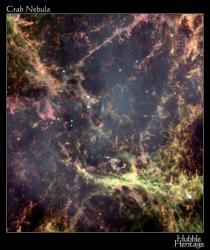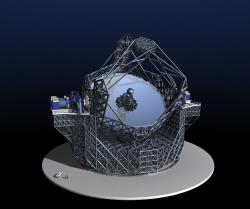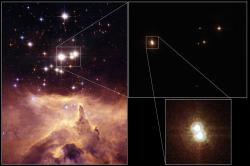 No more suspense. This week we blow the biggest stars up. Kaboom. Want more details? Then you’ve got to listen.
No more suspense. This week we blow the biggest stars up. Kaboom. Want more details? Then you’ve got to listen.
Continue reading “Podcast: We’re All Made of Supernovae”
Studies Will Proceed on Extremely Large Telescope
 The European Southern Observatory’s governing body has agreed to proceed with detailed studies for a new, Extremely Large Telescope. The study alone has a budget of 57 million euros, and should lead to the beginning of construction in 3 years. If everything goes well, the ELT will become the world’s largest telescope, spanning 42 metres. It will have 100 times more light-gathering capacity than the largest current telescopes. The final cost will probably be more than 800 million euros.
The European Southern Observatory’s governing body has agreed to proceed with detailed studies for a new, Extremely Large Telescope. The study alone has a budget of 57 million euros, and should lead to the beginning of construction in 3 years. If everything goes well, the ELT will become the world’s largest telescope, spanning 42 metres. It will have 100 times more light-gathering capacity than the largest current telescopes. The final cost will probably be more than 800 million euros.
Continue reading “Studies Will Proceed on Extremely Large Telescope”
Heavy Stars Embedded in NGC 6357
 This Hubble photograph shows star cluster Pismis 24, which lies at the heart of emission nebula NGC 6357. The stars are some of the most massive ever seen in our galaxy, each of which weighs at least 100 times the mass of our Sun. Astronomers originally thought it was two stars, each of which exceeded the theoretical limits on stellar size. Hubble discovered that it’s actually three stars, bringing the reality back in line with theory.
This Hubble photograph shows star cluster Pismis 24, which lies at the heart of emission nebula NGC 6357. The stars are some of the most massive ever seen in our galaxy, each of which weighs at least 100 times the mass of our Sun. Astronomers originally thought it was two stars, each of which exceeded the theoretical limits on stellar size. Hubble discovered that it’s actually three stars, bringing the reality back in line with theory.
Continue reading “Heavy Stars Embedded in NGC 6357”
What’s Up this Week: December 11 – December 17, 2006
Greetings, fellow SkyWatchers! We’ll start off the week in living color and end it fishing for galaxies in Pices. Along the way, we’ll have a look at the dark side as we study obscuration nebula… and you won’t have to say “Betelguese” three times to study this bright star! If you were disappointed in missing this year’s Leonid meteors, then you better watch out and you better not pout… Because the Geminids are coming to town! I’ll race you to dark skies, because…
Here’s what’s up!
Continue reading “What’s Up this Week: December 11 – December 17, 2006”
Vote for Bad Astronomy!
I try not to get involved in political matters, but sometimes I’ve just got to take a stand. You might have heard that my good friend Phil Plait from Bad Astronomy (and co-forum administrator) is up for a Weblog 2006 award for the best science blog. Unfortunately, he’s up against some ferocious competition, including Pharyngula and Real Climate, two of my other favourite blogs. So vote for Bad Astronomy. You can actually vote once every 24 hours, so vote early, vote often. Stuff that ballot.
Fraser
Discovery Blasts Off in Rare Night Launch
The space shuttle Discovery blasted off Saturday night, beginning a new mission to the International Space Station. The launch was initially scheduled for Thursday night, but low clouds forced managers to push it back. Over the next 12 days, Discovery will link up the station, and the astronauts will help install the new P5 truss. This structure will extend the station’s backbone, and allow future solar panels to rotate. Discovery will reach the station on Monday.
Continue reading “Discovery Blasts Off in Rare Night Launch”
What Makes the Biggest Impact on Galactic Evolution?
Astronomers assume that the galaxies we see today are the result of billions of years of evolution. Collision after collision turned small, irregular galaxies into majestic spirals like our Milky Way. But does the evolution depend on starting conditions, or is it all about the galactic collisions? A recent survey of more than 6,500 galaxies at various distances shows the environment of the early Universe made a significant impact on the evolution of the galaxies we see today. So both the early environment and ongoing collisions played a part.
Continue reading “What Makes the Biggest Impact on Galactic Evolution?”
Large and Small, Black Holes Feed the Same Way
Whether you’re dealing with a stellar mass black hole, or a supermassive black hole at the heart of a galaxy, it appears they consume matter in much the same way. It’s all just an issue of scale. Researchers have studied the accretion disks around both stellar and supermassive black holes, and found they seem to emit the same pattern of X-rays. Because of their size, the supermassive variety consume matter over long periods. By studying the smaller variety, researchers can model what will happen on larger scales.
Continue reading “Large and Small, Black Holes Feed the Same Way”
New Spurts of Water Discovered on Mars
Just when you thought Mars was dead, it goes and surprises you. New images released from the Mars Global Surveyor shows new gullies on the surface of Mars that formed within the last 7 years. The shape and path taken down the slope suggests that they were carved by rushing liquid water. It’s possible that there are quantities of liquid water underneath the surface, which can escape to the surface from time to time. Even though Mars can get cold, researchers think that water spurting out of the ground could last long enough to carry debris down the slope of a hill before freezing solid.
Continue reading “New Spurts of Water Discovered on Mars”
Supermassive Black Hole Mashes Up and Consumes a Star
A supermassive black hole in a distant galaxy has been caught in the act of consuming a star. In fact, NASA’s Galaxy Evolution Explorer was able to watch the entire process, from the beginning to the end. A some point in the recent past, a star got too close to the supermassive black hole, and was torn apart. The shreds swirled around the black hole, and the Galaxy Evolution Explorer spotted the bright blast of ultraviolet light.
Continue reading “Supermassive Black Hole Mashes Up and Consumes a Star”
